|
|
Used to design the electronic report for submission (upload) to National NetDMR.
NOTE: Please see NetDMR-EZ for an alternative (typically easier) method to creating the NetDMR. |
 |
The locate tool is used to design a spread report that will produce a CSV file that meets the NetDMR Import File Specifications (as outlined in NetDMR National Installation Permittee and Data Provider User Guide, May 1, 2009, see attached). Users will then be able to login to a NetDMR system and use the NetDMR's Import DMRs function to submit the data. The NetDMR is an electronic version of the NPDES DMR printed report.
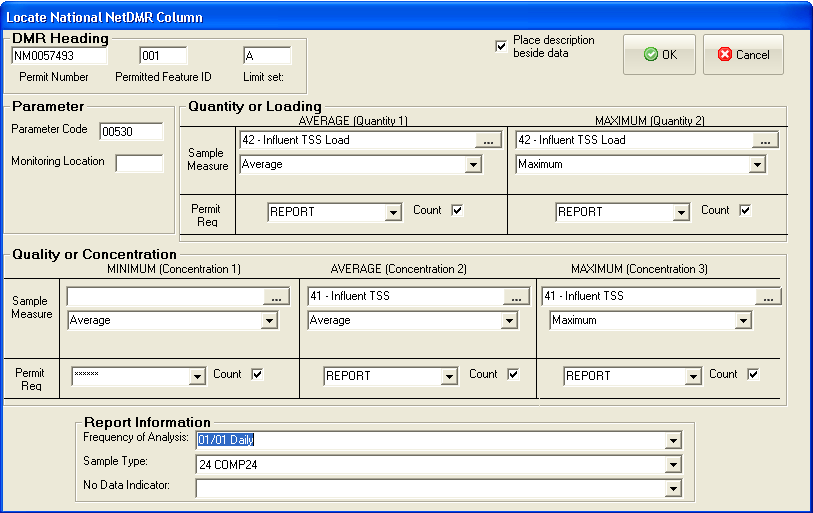
The paper NPDES DMR (Form 3020) can be used to help map your NetDMR fields. You may also want to log into the NetDMR system and use the edit DMR which will give you the layout and required fields for the NetDMR.
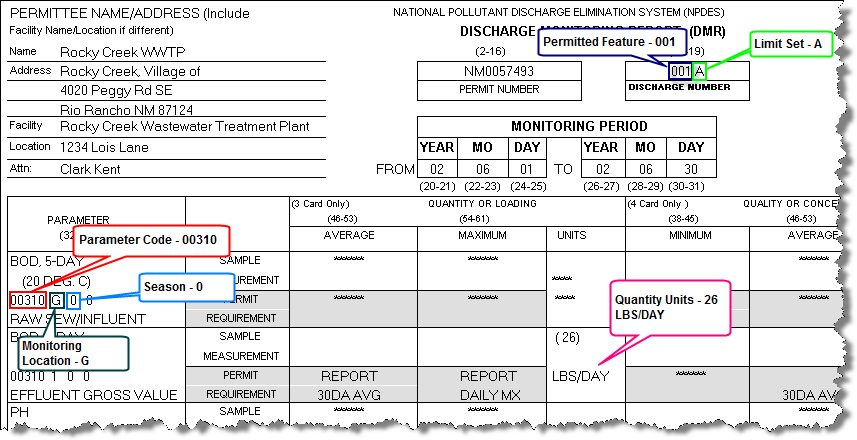
FIELDS:
| Field |
NetDMR Field |
Column |
Excel Column |
Notes |
| Permit Number |
permit_id |
1 |
A |
Permit Number in all upper case, NM0057493. Note, field was added in July 2012. |
| Permitted Feature ID |
permitted_feature_id |
2 |
B |
001 |
| Limit Set |
limit_set_txt |
3 |
C |
A |
| Monitoring period end date |
mped_txt |
4 |
D |
End date of the report in yyyy-mm-dd |
| Form NODI Code |
form_nodi_cd |
5 |
E |
NODI code for entire DMR form. Typically blank. |
| Parameter Code |
parameter_cd |
6 |
F |
Storet Code for the parameter, 00400 |
| Monitoring Location Code |
monitoring_location_cd |
7 |
G |
|
| Season |
season_num |
8 |
H |
Identifies the limits to use with seasonal limits (number 0-12). Typically, is a value of 0 (zero) if the limit does not change (i.e. you do not have seasonal limits). If you have seasonal limits, this number will need to change depending on the month you are reporting. You may want to request a Limit Summary report from the state (or regulatory agency) in order to see your limits and associated season. |
| Quantity 1 NODI Code |
quant_1_nodi_cd |
9 |
I |
A NODI code to indicate that there is no data for the reporting period. Typically blank. |
| Quantity 1 Qualifer |
quant_1_qualifier_txt |
10 |
J |
The qualifier of the numeric condition. It specifies whether the condition is greater than, less than, and/or equal to the NumericConditionValue. This field may also indicate if the value is estimated (E) or too numerous to count (T) when applicable. If no qualifer exists, should be set to "=". Valid values =,>=,=>,<,>,T,E. Note, if qualifer = T the value must be populated. |
| Quantity 1 Sample value |
quant_1_sample_num |
11 |
K |
The numeric result with no commas. Example, the average flow is 3.75. |
| Quantity 1 Effluent value |
quant_1_effluent_num |
12 |
L |
Typically left blank. This field may be used to specify the limit value in the future (not verified). |
| Quantity 2 NODI Code |
quant_2_nodi_cd |
13 |
M |
|
| Quantity 2 Qualifer |
quant_2_qualifier_txt |
14 |
N |
|
| Quantity 2 Sample value |
quant_2_sample_num |
15 |
O |
|
| Quantity 2 Effluent value |
quant_2_effluent_num |
16 |
P |
|
| Quantity units of measure |
quant_uom_cd |
17 |
Q |
Unit of measure abbreviation. Should leave blank as NetDMR will default the units as it is imported. |
| Concentration 1 NODI code |
conc_1_nodi_cd |
18 |
R |
|
| Concentration 1 Qualifier |
conc_1_qualifier_txt |
19 |
S |
|
| Concentration 1 Sample value |
conc_1_sample_num |
20 |
T |
|
| Concentration 1 Effluent value |
conc_1_effluent_num |
21 |
U |
|
| Concentration 2 NODI code |
conc_2_nodi_cd |
22 |
V |
|
| Concentration 2 Qualifer |
conc_2_qualifier_txt |
23 |
W |
|
| Concentration 2 Sample Value |
conc_2_sample_num |
24 |
X |
|
| Concentration 2 Effluent Value |
conc_2_effluent_num |
25 |
Y |
|
| Concentration 3 NODI code |
conc_3_nodi_cd |
26 |
Z |
|
| Concentration 3 Qualifer |
conc_3_qualifier_txt |
27 |
AA |
|
| Concentration 3 Sample Value |
conc_3_sample_num |
28 |
AB |
|
| Concentration 3 Effluent Value |
conc_3_effluent_num |
29 |
AC |
|
| Concentration units of measure |
conc_uom_cd |
30 |
AD |
|
| Number of Excursions |
excursions_num |
31 |
AE |
Count of number of violations (exceedances) for the parameter. Will count all violations where a Permit Requirement is picked and the Count check box is checked: |
| Frequency of Analysis |
freq_analysis_cd |
32 |
AF |
The code that indicates the frequency with which the permittee must analyze the sampled data. The general format is XX/YY where XX= number of times sampled and YY = period of time sampled |
| Sample Type |
sample_type_cd |
33 |
AG |
The code that is the sampling method required by the permit to be used to provide measurement values on the DMR |
| Parameter NODI Code |
param_nodi_cd |
34 |
AH |
The NODI code for this particular parameter. |
| Comment Text |
comment_txt |
35 |
AI |
This is for any comments that need to be added to the DMR, enter comment on the first line of the DMR only.
NOTE: This field was added March 2015. See Update existing netDMR report for new Comment Text field if you are editing an existing report. |
Fill out the form and click OK. Note: Use your existing NPDES DMR as a guide.
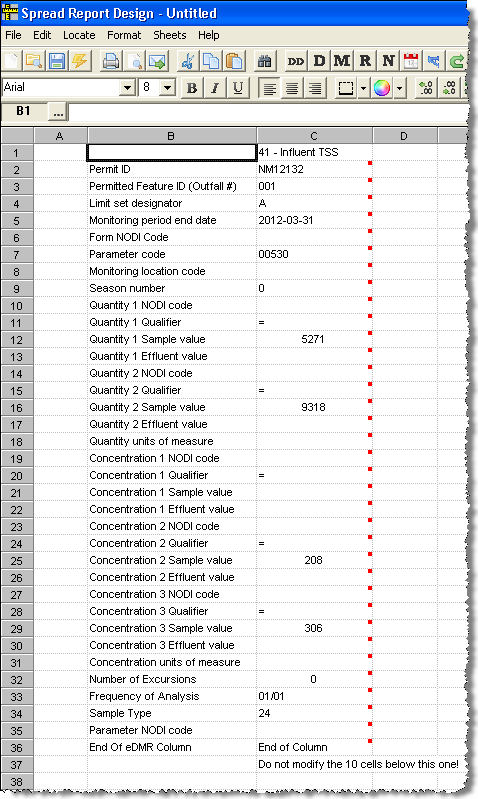
Repeat for each parameter in your NDPES DMR, save the report. The parameters can be in any order, they do not need to match the order of the report online.
Blank columns or columns with text like column "B" above can exist anywhere.
Parameters in your WIMS Spread Report not required for the current month's report will be ignored by the NetDMR Import function.
Use Report Pac, Spread Reports to produce your NetDMR file for upload.
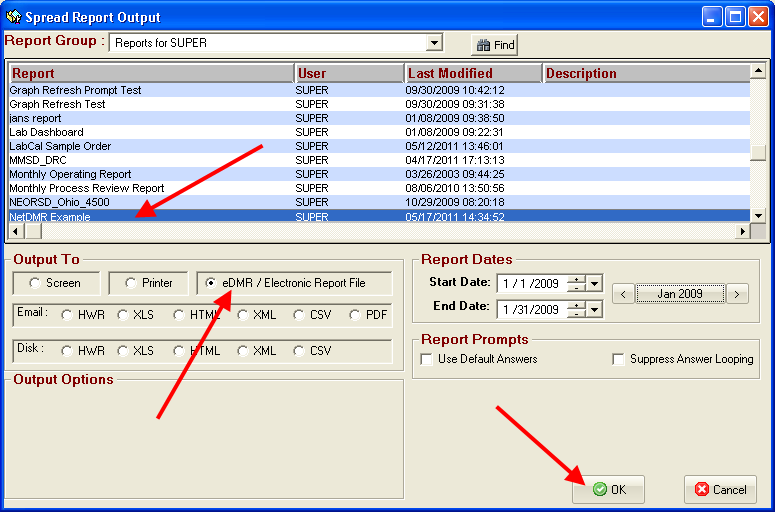
After clicking [OK], the next screen you see is this:
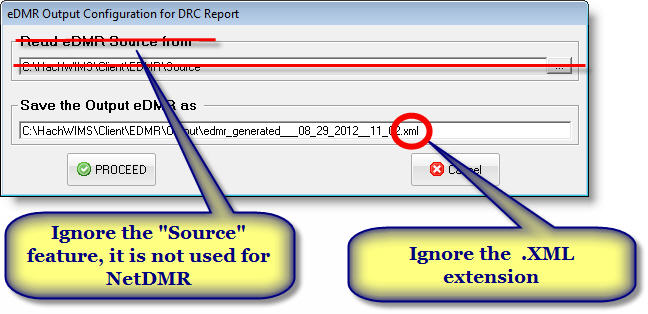
The "Source" feature is not used for NetDMR, so ignore it.
The default file extension shown is ".xml". As .xml is not a supported file type for the NetDMR, WIMS will automatically create a .TXT file type and replace ".xml" with ".txt" in your file name.
You can edit the name and location of the Output eDMR file, but you must follow these rules:
The file name must not have any spaces in it.
You must include a file extension, either ".txt" or ".csv".
Click [Proceed] to generate your file. The following dialog will appear. It will always say that a TXT File is being generated whether you expected a CSV or a TXT file. Rest assured the filetype will be correct, this is simply a display problem.
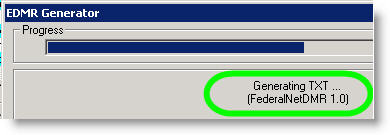
Once the form is generated you will see the following message:
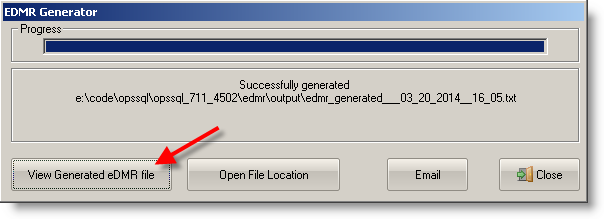
If you click [View Generated eDMR file] you will see a file like this:
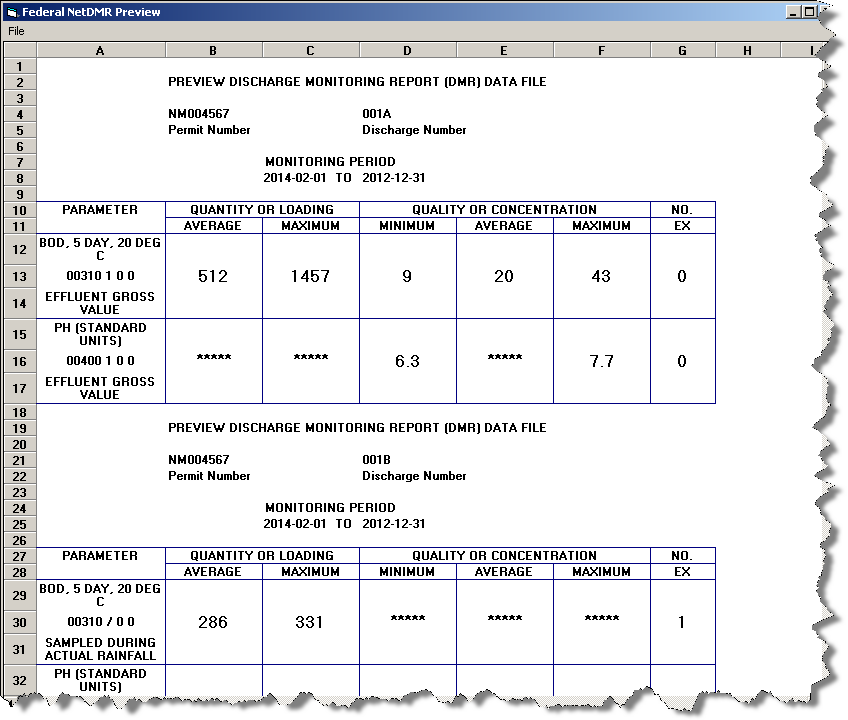
Some of the supported states include:
Alabama, Alaska, Arkansas, California, Colorado, Connecticut, District of Columbia, Florida, Georgia, Idaho, Kentucky, Louisiana, Maryland, Massachusetts, Mississippi, Montana, Navajo Nation, New Hampshire, New Mexico, North Carolina, Oregon, Puerto Rico, South Carolina, South Dakota, Tennessee, Texas, Utah, and Washington.
List of states supported is updated continously on EPA's site : https://netdmr.zendesk.com/entries/45318090-For-New-Users-Who-Can-Report-
Tips and Tricks:
1. There are 34 fields in the NetDMR CSV file as of July 2012. If you receive a message similar to the following when uploading the file, you need to add your Permit Number to your report as it was not previously required.
Error Insufficient Columns Line 1: Incorrect number of fields. There should either be 34 or 5 fields, but 33 were found.
See Updating existing NetDMR to include Permit ID for instructions on how to fix.
2. Do not fill in the units. The NetDMR system will default your units during upload.
3. Enter your permit id in UPPER case.
4. Use the attached NetDMR_Template_Import_DMR_20120709.xlsx to line up the columns to verify data is in the right order. Rename your EDMR.txt to CSV, paste in the header row from the attached file and see if the fields line up.
5. Do I need to produce the 5 column No Data file? No, the first file layout (5 column) is used when the entire DMR form has a “No Data” value entered. (ie No Discharge) and is rarely used.
6. See the EPA's NetDMR website for Permittees - http://www.epa.gov/netdmr/permittees/index.html
|